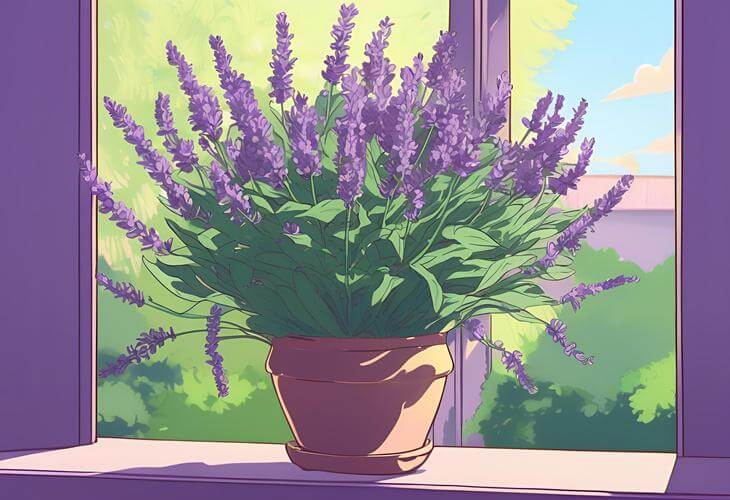
Lavender (Lavandula spp.) is one of the most cherished herbs in the world, admired for its fragrant foliage, delicate flowers, and exceptional versatility. Native to the Mediterranean region, lavender has found a permanent home in American gardens thanks to its drought tolerance, ornamental beauty, and soothing aroma.
Whether used in culinary recipes, herbal remedies, floral arrangements, or pollinator gardens, lavender is a hardy and attractive choice. It’s particularly appreciated for its long-lasting blooms, ability to repel pests, and its irresistible appeal to beneficial pollinators. Its silver-green leaves and spikes of purple, blue, pink, or white flowers bring a touch of elegance and tranquility to any landscape.
Soil (pH) Requirements
Lavender thrives in well-drained, sandy or loamy soil with a slightly alkaline pH, ideally ranging from 6.5 to 8.0. Good drainage is essential—lavender’s roots are prone to rot in overly moist or compacted soil.
Tips for Optimal Soil
- Amend clay soil with sand, gravel, or perlite to improve drainage.
- Avoid overly rich soils, which can lead to leggy plants and reduced oil concentration.
- Add lime to acidic soils to increase pH if necessary.
Sun Requirements
Lavender is a sun-loving plant that needs at least six to eight hours of full sunlight daily to thrive. In cooler climates, plant in the sunniest available spot. In hot regions, some afternoon shade can help reduce heat stress, especially for young plants.
Ideal Locations
- South-facing beds
- Sunny slopes or rock gardens
- Raised beds with full exposure
Watering Requirements
Lavender is a drought-tolerant perennial, especially once it’s established. Overwatering is a common mistake and can lead to fungal issues or root rot.
Watering Guidelines
- Water deeply but infrequently—only when the top 1–2 inches of soil is dry.
- Allow the soil to dry out between waterings.
- Newly planted lavender needs more frequent watering until roots are established (about three to four weeks).
Best Plant Hardiness Zones
Lavender’s hardiness depends on the variety, but most types grow well in USDA Zones 5 through 9. Some cultivars tolerate colder climates, while others are better suited for hot, dry conditions.
Tips for Winter Care
- In colder zones, mulch lightly with gravel or straw to protect roots.
- Avoid heavy mulches that hold moisture, which can damage plants over Winter.
- Consider planting in raised beds or containers for better drainage and flexibility.
Lavender’s Popularity and Pollinator Power
Lavender’s global appeal is no accident. It seamlessly blends beauty, fragrance, and function. In the garden, it acts as both a pollinator magnet and a pest repellent. In the home, it’s used in everything from teas and soaps to sachets and delicious recipes.
One of the biggest benefits of lavender is its powerful draw for pollinators. Its long-blooming flowers are rich in nectar and attract a wide array of beneficial visitors, including:
- Honeybees
- Bumblebees
- Mason bees
- Butterflies
- Hoverflies
- Occasionally hummingbirds, especially where other nectar-rich flowers are present
Lavender is especially valuable during Summer when many other blooms fade, offering consistent nectar through the heat.
Five Beautiful and Useful Lavender Varieties
English Lavender
This classic variety is prized for its sweet scent and compact, tidy growth. It blooms in early to midsummer and is often used in culinary and ornamental applications.
Popular Uses
- Dried lavender sachets and teas
- Fragrance oils and cosmetics
- Edible flowers for cookies, lemonade, and syrups
Pollinator Bonus: Produces nectar-rich flowers that are highly attractive to honeybees and small native bees.
Best Zones: 5–8
French Lavender
Known for its fringed, toothed leaves and long flowering season, French lavender adds a lush, almost tropical look to the garden. Its scent is more piney than sweet, but equally lovely.
Popular Uses
- Ornamental borders and containers
- Herb wreaths and potpourri
- Landscape design in warm regions
Pollinator Bonus: Provides extended nectar access for hoverflies and butterflies, particularly in southern gardens.
Best Zones: 8–11
Spanish Lavender
Easily recognizable by its “rabbit ear” bracts at the top of each flower spike, Spanish lavender brings dramatic flair and early color. It’s often the first lavender to bloom in Spring.
Popular Uses
- Eye-catching landscape plant
- Early-season cut flower arrangements
- Container gardening
Pollinator Bonus: An early food source for native bumblebees emerging in Spring and a favorite of butterflies.
Best Zones: 7–10
Lavandin
A hybrid between English and Portuguese lavender, Lavandin varieties (such as Grosso and Provence) are known for their tall, robust growth and high oil yield. These plants bloom in midsummer with long, showy flower spikes.
Popular Uses
- Essential oil distillation
- Lavender wands, sachets, and soaps
- Tall, fragrant garden borders
Pollinator Bonus: Loved by mason bees and honeybees alike. Its large flower heads offer extended foraging space.
Best Zones: 5–9 (some varieties are more heat-tolerant)
Munstead Lavender
Munstead is a compact cultivar of English lavender, favored for its consistent bloom, cold tolerance, and tidy mounding habit. It’s a garden classic.
Popular Uses
- Edging herb beds and walkways
- Growing in pots or raised beds
- Culinary garnishes and infused syrups
Pollinator Bonus: Blooms reliably each year and supports small native bees and butterflies throughout the season.
Best Zones: 4–9


 Previous
Previous

